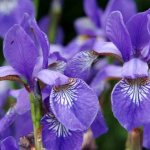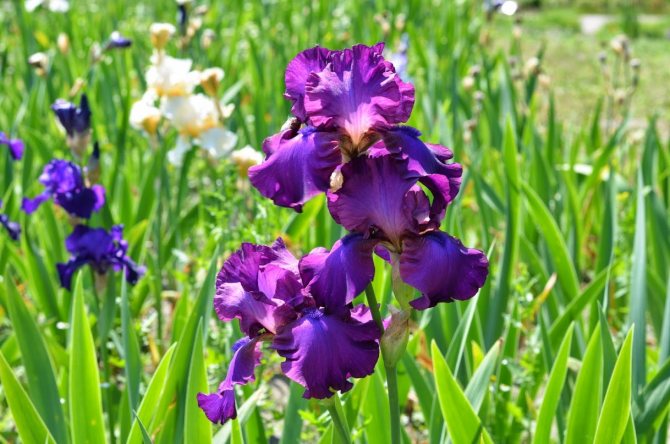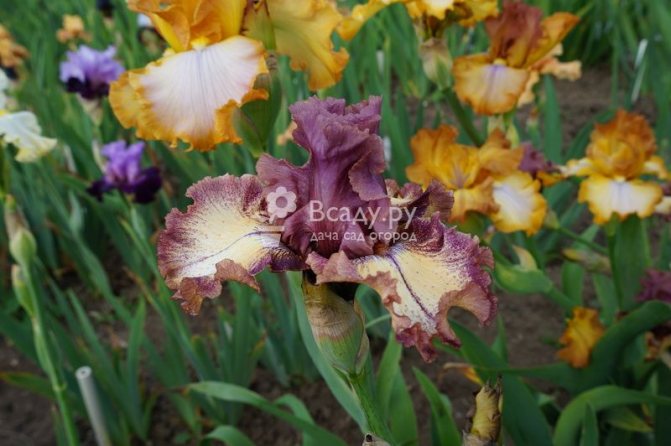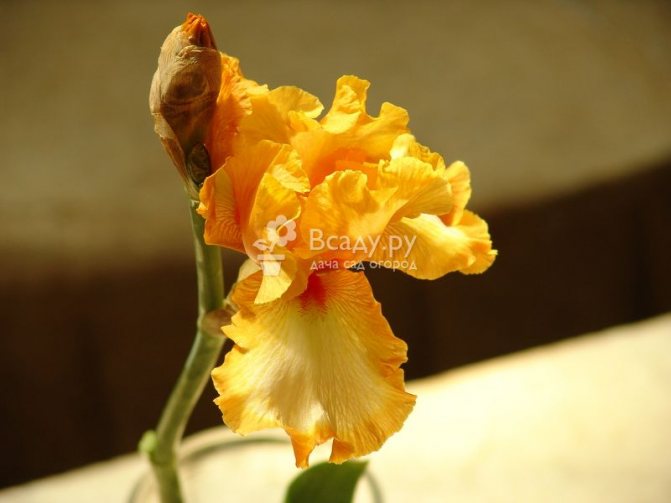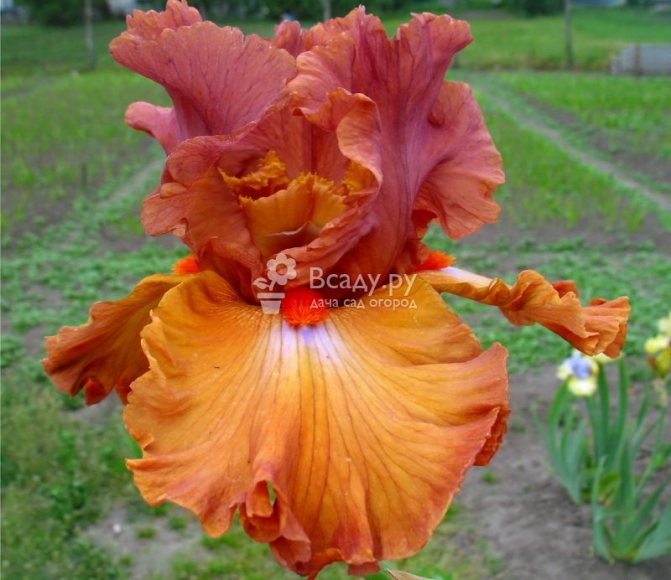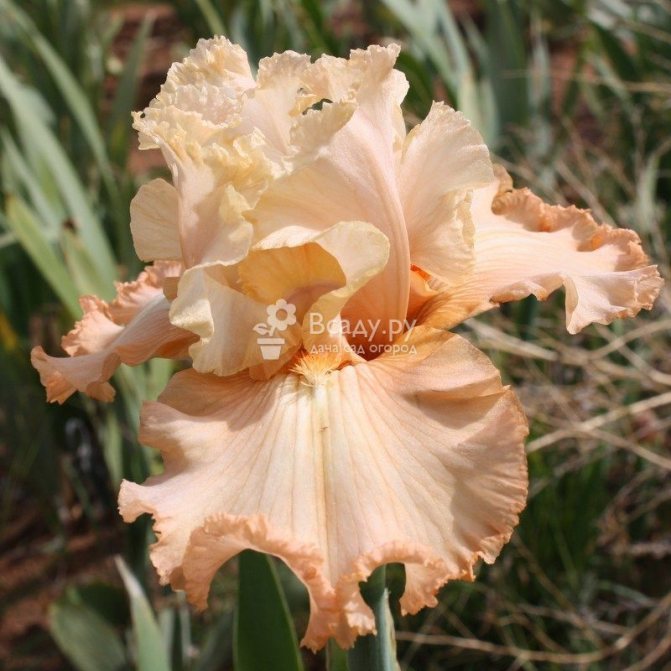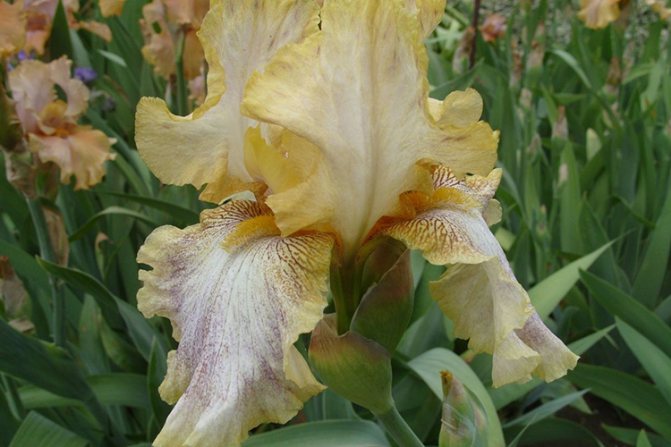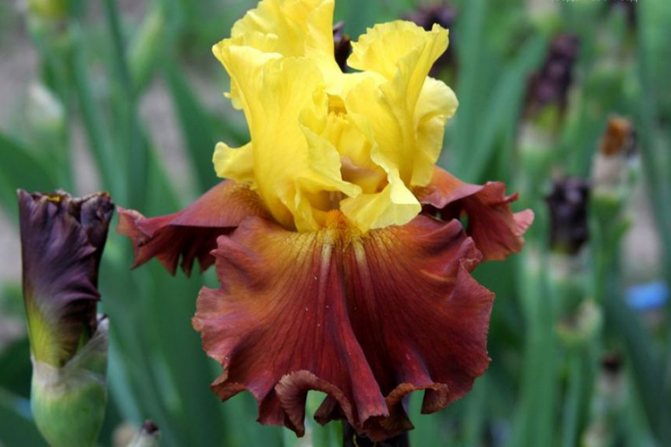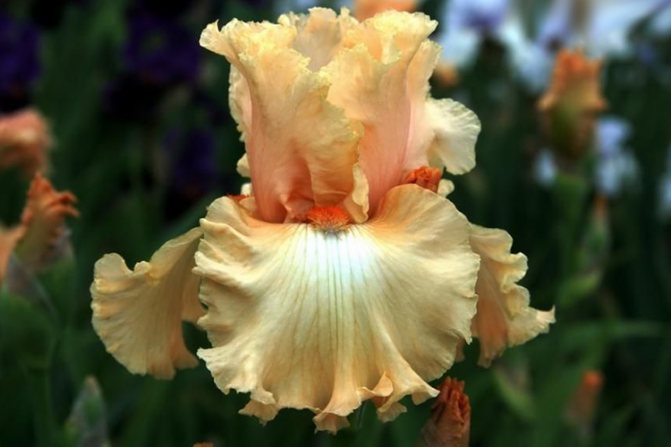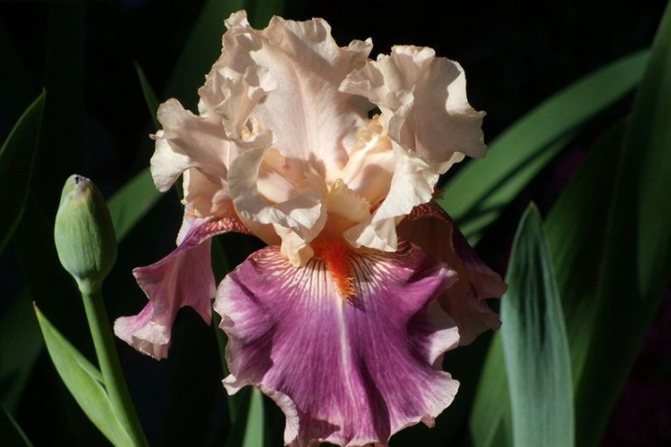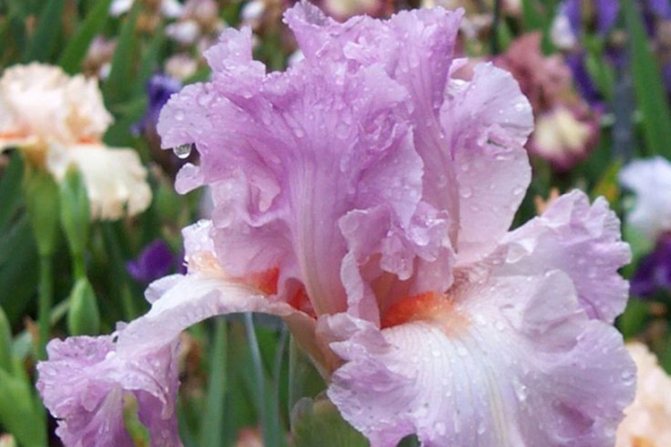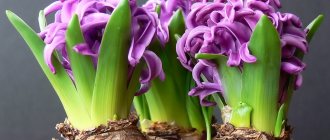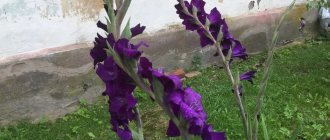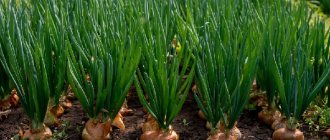Content
- Listen to the article
- Planting and leaving
- Description
- Growing features
- Planting irises When and where to plant
- Planting in spring
- Planting in autumn
- How to care
- Bearded irises
Beautiful bearded irises

Representatives of this category are among the most popular, as they differ in a wide color range, long flowering and many hardy varieties.
Sunset in Avalon
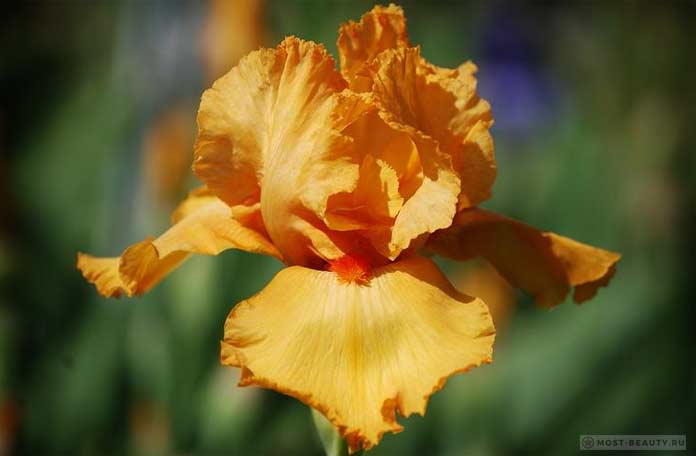

Looking at the corrugated sun-orange petals of this iris variety, which shimmer in the sun with apricot and coral shades, one cannot help believing that indeed these flowers once adorned the fabulous garden of the mythical fairy Morgana and absorbed the most wonderful colors of the sunset on the legendary island of Avalon.
Bird of paradise


Planting and caring for irises
- Landing: species plants - by sowing seeds in open ground before winter or after stratification of sowing material in spring. Varietal - by dividing the rhizomes and planting them in the ground every 3-4 years after flowering.
- Bloom: from May to mid-summer.
- Lighting: bright sunlight in the morning.
- The soil: fertile, drained, cultivated to a depth of 20 cm, in composition - light or medium, neutral or slightly alkaline.
- Watering: regular, sufficient, abundant during the budding period.
- Top dressing: mineral complex fertilizers in liquid form before flowering. Do not feed during flowering. Do not use organics.
- Reproduction: seed, vegetative (by dividing the rhizome).
- Pests: gladiolus thrips, scoops, aphids, root onion mites, onion hoverflies, stem, strawberry and rootworm nematodes, slugs, bears, wireworms, beetles.
- Diseases: bacteriosis, gray rot, fusarium.
Read more about growing irises below.
Iris (Latin Iris), or Iris, or Cockerel - a genus of rhizome perennials of the family Iris, or Iris (Iridaceae). Irises grow everywhere and have about 700 species of all kinds of shapes and shades. In translation, iris means "rainbow". So named the flower Hippocrates in honor of Iris, the goddess of the rainbow.Legend says that when Prometheus gave people fire, a rainbow flared up - so nature rejoiced. The rainbow shimmered all day, evening and night, and when the darkness receded and the sun rose, everyone saw that amazing irises bloomed on the ground - flowers that looked like rainbows. Florence (translated as "blooming") got its name from the Romans because the fields around the city were dotted with irises. The iris flower has been cultivated for more than two thousand years. And they are grown not only as a decoration for gardens, but also as a valuable raw material for the production of essences in the perfumery industry.
Siberian irises
Our compatriot Siberian iris in the photo looks like a bearded relative, but in the structure, agricultural technology and description of the flower it has a number of differences.
- The shape of the flower is similar, but it is somewhat smaller, without a beard, the petals are narrower and elongated. Although in fairness it must be said that some modern varieties in flower size can compete with irises beards.
- The plant grows into large bushes and simply expels a huge number of flower stalks.
- The foliage of this species is brighter and more elegant, serves as a decoration for the garden even after flowering.
- The species is extremely hardy, cold-resistant, more reliable in adverse weather conditions.
- Unlike the bearded iris, this flower can grow and bloom in the shade.
Unfortunately, Siberian irises do not smell. But this does not detract from the decorative possibilities of the flower and the interest in it on the part of breeders.
Assortment of Siberian irises
Dozens of varieties and hybrids of Siberian irises for every taste have been bred in the world, some of them we have collected in this collection with photos and names.
- The Snow Queen is a tall "Siberian" with bright green foliage and an incredibly graceful medium-sized flower (ø 10 cm). The petals are snow-white, in the places where the fouls bend - with a bright yellow back. Blooms in July. In especially cold winters, in order to avoid freezing of generative buds, it is better to cover.
- Cambridge is a time-tested, reliable and highly decorative variety. The height of the bush is 80–100 cm. The flower is medium-sized, graceful, with soaring azure-blue petals and a yellow base. It grows quickly, blooms profusely. The variety is resistant to severe frosts.
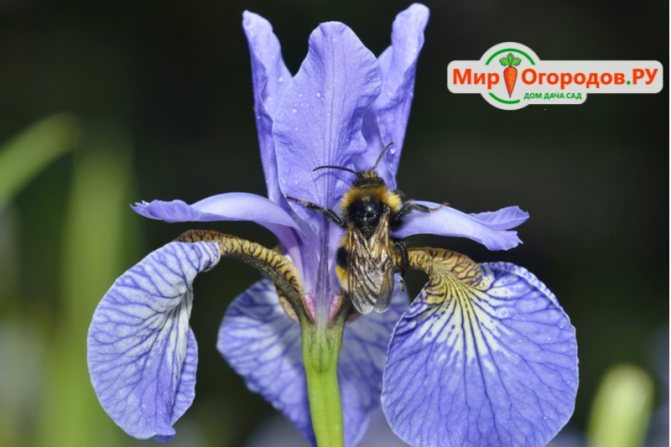

Sky blue iris cambridge - Impression is a medium-sized representative of Siberian irises with half-meter peduncles. The flower plays with a mixture of violet-red and amethyst color with tiger strokes at the base of the lower petals, the styles are almost white.
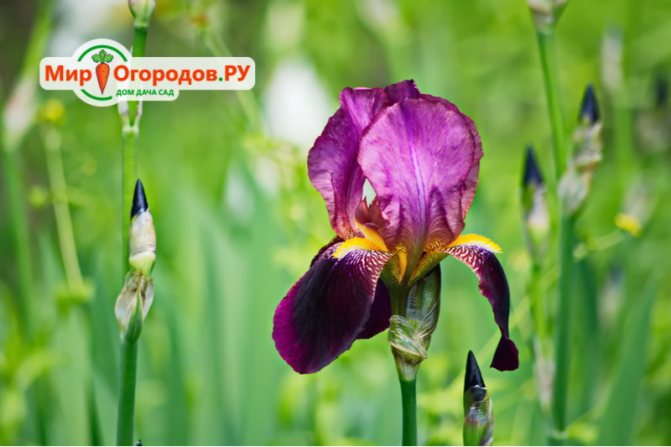

Amethyst Iris Impression - Magnum Bordeaux is an impressive hybrid with a very large floating flower on a 70 cm stem. The petals are slightly corrugated, with a velvet texture, very elegant. The deep purple color is complemented by blue-yellow spots at the base of the fouls and purple streaks.
- Double Standard is a representative of the collection of Siberian terry irises. The flower is blue with a lavender tint, there is a contrasting yellow spot on the fouls. The petals are velvety, dense, slightly corrugated. Blooms in June. The variety is recommended by leading growers as unpretentious, frost-resistant, intensively growing.
- Jinje Twist is a tall, early, abundantly flowering Siberian. The flower is two-colored - the upper lobes are light fawn with lavender spots, the fouls are ocher-yellow, turning into a mustard edge, with brown veins and small splashes of lavender. One of the few smelling varieties of Siberian irises.
Iris flowers - description
Irises are rhizome plants. Cord-like or filiform roots grow on the rhizome. Peduncles (one or more) are annual. The leaves are flat, xiphoid, thin, two-rowed, sometimes linear, with a waxy coating. They are collected in fan-shaped bunches at the base of the peduncle, there are almost no stem leaves. Flowers in irises are single, sometimes in small inflorescences, large, often fragrant, distinguished by an intricate graceful shape and are painted in a variety of colors and their combinations.The flower has six petals (in fact, these are the perianth lobes). The three outer lobes are slightly turned downwards, and they usually differ in color from the upper lobes, which, having grown together at the bottom, form a tube. Irises bloom from May to July, two or three flowers bloom simultaneously from one to five days. Iris fruit is a three-celled capsule.
- Physalis: planting and care in the open field
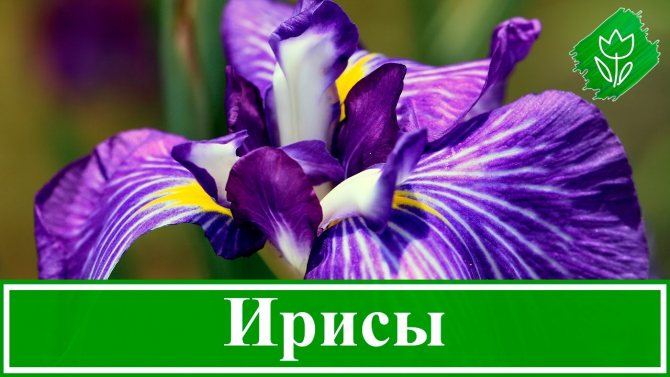

Varieties of irises
"Iris" is a generalized designation of several different plants at once with different types of root system: rhizome and bulbous. It is worth noting that neither the rhizome nor the bulb are roots - they are thickened shoots. At the moment, there is no generally accepted classification of the Iris genus. That is why in the domestic taxonomy, only irises with a rhizome type of the root system are considered real irises, while in the world, on the contrary, bulbous irises are recognized. Although these flowers have differences in the root system, it is possible to quite clearly describe what an iris looks like: an annual flower stalk, a flower growing on it, a large single, with a strong aroma. The flower itself is 6 petals arranged in two tiers: three outer petals (fouls) are bent outward, and three inner (standards) are raised up like a dome. The leaves are thin, flat, and have a waxy coating.


Irises rhizome
Irises with a rhizome type of root system are divided into two large groups: bearded and non-bearded. They are unpretentious, tolerate the Russian winter well.
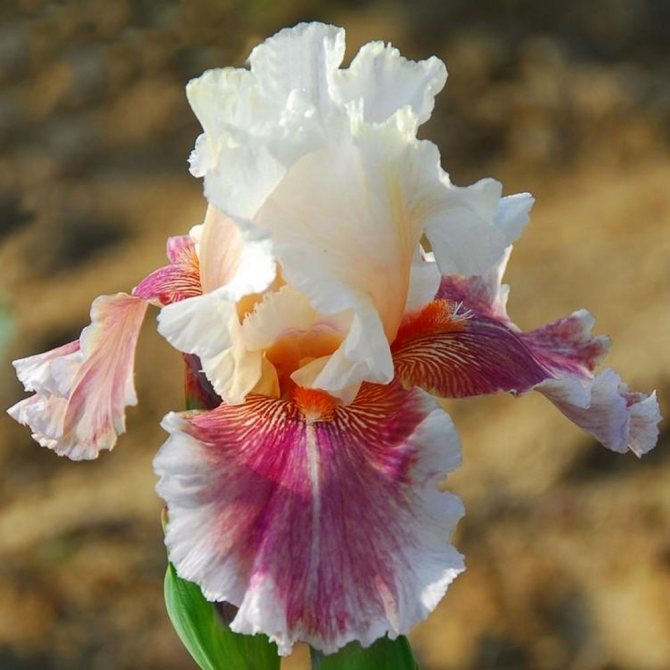

Bearded iris


Iris beardless
Bulbous irises are also divided into groups: iridodictium, xyphium and juno. The genus Xyphyum is divided into six species that are widely used in breeding. Thanks to the crossing of these species, today the selection of irises has increased many times over. These are Dutch, Spanish and English hybrid bulbous irises, striking in their beauty.
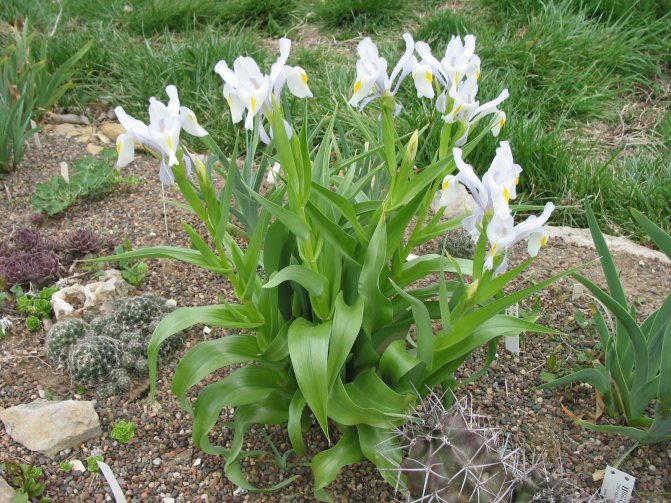

Iris bulbous of the Juno group
Growing iris - features
Many hobbyists refuse to breed irises, believing that this is a very difficult process. In fact, growing irises is by no means tedious and time consuming as it seems. You just need to know some of the subtleties that distinguish the care of these beautiful flowers.
Firstly, the peculiarity of irises is that their rhizomes grow horizontally and often become bare, coming to the surface. Therefore, irises in winter must be sprinkled with earth and peat so that they do not freeze. In the spring, this cover is carefully removed.
Secondly, irises love to move, and in one year they can shift their position to the side by a few centimeters. To make the rows look smoother, you need to plant irises with a fan of leaves along, not across the row.
How to plant lilies correctly, how to care for them after
Thirdly, bearded iris should be planted on the sand: sand is poured into the bottom of the hole and the iris root is spread over it. If planted deeply, the iris will either disappear or will not bloom.
Fourth, don't feed irises with organic fertilizers, they don't like them. The best type of feeding is mineral fertilizers in liquid form.
Japanese irises
The xiphoid irises that grow in Japan and in our Far East are called Japanese. This is not a specific, but rather a collective term. For a long time they were considered unsuitable for cultivation in the northern regions, they were grown in Primorye, in the Caucasus, the Black Sea coast. Breeders are trying to actively promote the culture to the north, more or less frost-resistant varieties have appeared, but in general, the "Japanese" in the middle zone do not have enough heat and light.
The flower of the Japanese iris is very interesting - large (ø up to 25 cm), similar to a saucer. All 6 lobes are bent horizontally, only branches of pistils (styles) with an openwork comb at the end are raised upward. In addition to monochromatic and two-color varieties, common varieties are speckled, bordered, with contrasting colored veins. Let's give an example of several of them.
- Vasily Alferov is one of the first winter-hardy cultivars of domestic selection. Standards are white, fouls with blue-orange specks. The crisp white styles are finished with a fringed comb. On the arrow-shaped peduncle there are 3-4 flowers up to 20 cm in diameter.
- Kogesho is a xiphoid hybrid of Dutch selection, tall (80–120 cm). Leaves are light green with a central purple vein. The flower consists of a double row of lilac-white petals with a yellow spot at the base, styles are white with a coquettish comb. The variety hibernates under cover.
- Lyon King is a magnificent hybrid with a very large flower. Consists of 9 lobes, collected in a fluffy layering "skirt". Petals with snow-white centers and purple-pink corrugated edges, yellow smear is visible at the base of the central vein, styles are white. The variety is thermophilic.
- Crystal Helo is a frost-hardy plant with strong growth and lush flowering. The upper and lower petals are slightly corrugated along the edge, lowered down. The main field and styles are lavender-blue with purple veins, bright yellow strokes along the central vein of fouls.
- Freckled Geisha is a terry hybrid with nine lobes. Petals are snow-white with lilac-lilac specks and the same border, corrugated along the edge. The branches of the pistils are white with a lilac comb. Plant height - up to 85 cm.
Planting irises
When and where to plant irises
There is a general consensus that irises should be divided and replanted immediately after flowering so that they have time to set in before winter. But if autumn is warm and long in your area, you can take your time with the transplant. Actually, irises can be planted in spring, autumn and summer after flowering. The main thing is not to forget to transplant irises every 3-4 years, and Siberian irises - at least once every ten years, otherwise they degenerate, grow and stop blooming.
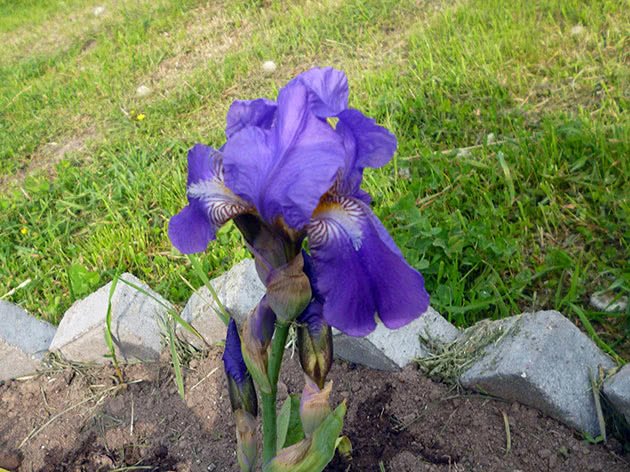

In the photo: Growing irises in a flower bed
It is necessary to plant bearded irises on slopes or hills that are well lit in the first half of the day, protected from drafts, so that there is an outflow of melt water and good drainage. Marsh and Siberian irises, on the contrary, love moist soil. But both irises like the soil rich, and if the soil on your site does not meet this requirement, apply oily garden soil or compost to the soil in the spring before planting, fertilize it with potassium-phosphorus fertilizers. If the soil is acidic, add dolomite flour, chalk or wood ash. If there is loam on the site, add peat and sand, if, on the contrary, the site is sandy, add clay soil. To decontaminate the area before planting, spill the area with a fungicide and treat with herbicides against possible weeds.
Do not use manure to fertilize the site.
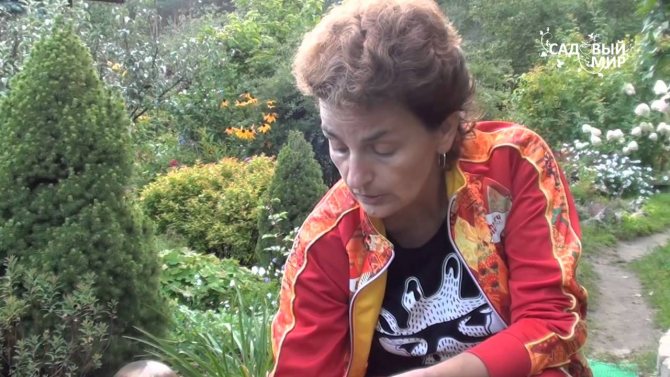

Planting irises in spring
Planting and caring for irises requires some knowledge, but not as much effort as it seems to beginner growers. Planting material, if it was stored for the winter or was purchased in a store, before planting, it is better to treat it with growth stimulants such as Ecoel or Zircon. Long roots must be carefully trimmed, rotten places must be removed, and the root must be kept for disinfection in a solution of potassium permanganate for 20 minutes.
The irises are planted as follows: sand is poured into a shallow hole, the rhizome of the bearded iris is placed horizontally on top, the roots are straightened, covered with soil so that the upper part of the rhizome remains above the level, and watered well. If you bury the entire rhizome, you can provoke its decay. Beardless irises, on the contrary, need to be buried a few centimeters and, in addition, mulched to retain moisture with fallen needles or peat. The distance between the irises should be at least half a meter.
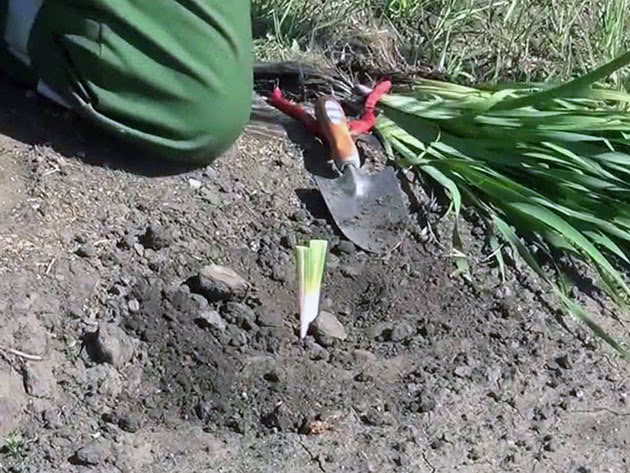

In the photo: How to properly plant irises in the open field
Planting irises in autumn
Irises are planted in spring in the same way as in autumn, or rather in late summer, namely after flowering. This usually happens from August to the end of September, although the sooner you plant, plant or transplant irises, the more you are sure that they will take root. You need to use a pitchfork to dig an iris bush, divide it into annual links with a leaf blade, carefully shorten the cord-like roots, cut out damaged or rotten places, disinfect a couple of hours in a solution of dark pink potassium permanganate, then dry for 4-5 hours in the sun. Planting irises is carried out in a way that is already known to you. The distance between low-growing irises is 15 cm, medium-sized irises - 20 cm, high-50 cm.


In the photo: Planting irises in a flower bed
Variety of types of flower


Bearded iris
Irises are classified into two basic types - beardless and bearded. And I must say that the latter type is in much greater demand. Bearded irises began to be called because of the delicate, "bristly" outgrowths on the outer lobules, which form the so-called "beard".
Depending on the color of the flowers, iris is subdivided into:


two-ton - all petals are painted in the same color scheme, but in different shades;
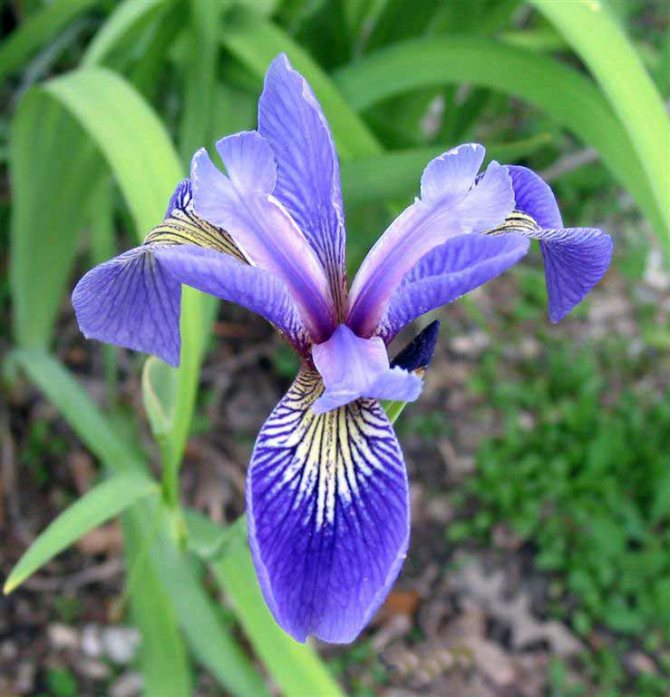

multicolored - the color of the outer and inner petals is different;
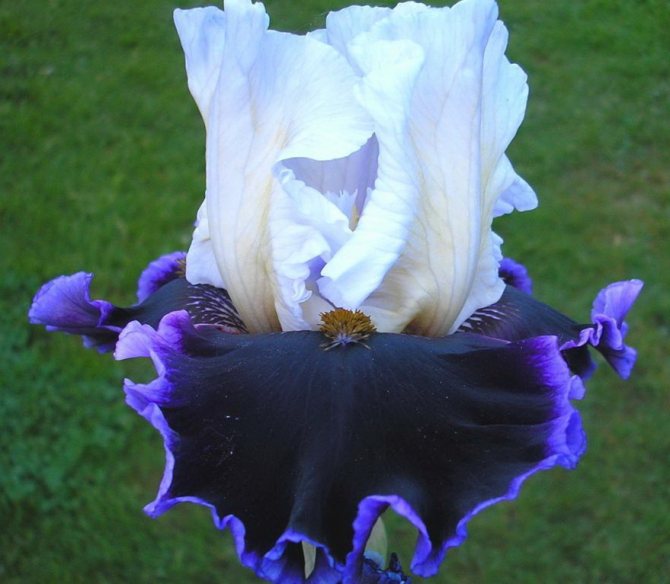

framed - a strip of contrasting color along the edge on all petals or only on the outer ones;
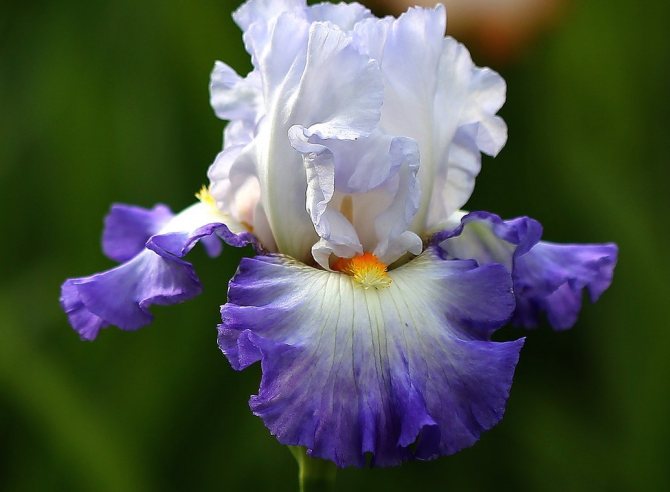

smooth - shades of one color smoothly transition into another.
The following are the most popular varieties of irises - these are the ones most often chosen by gardeners for outdoor use.
Dutch
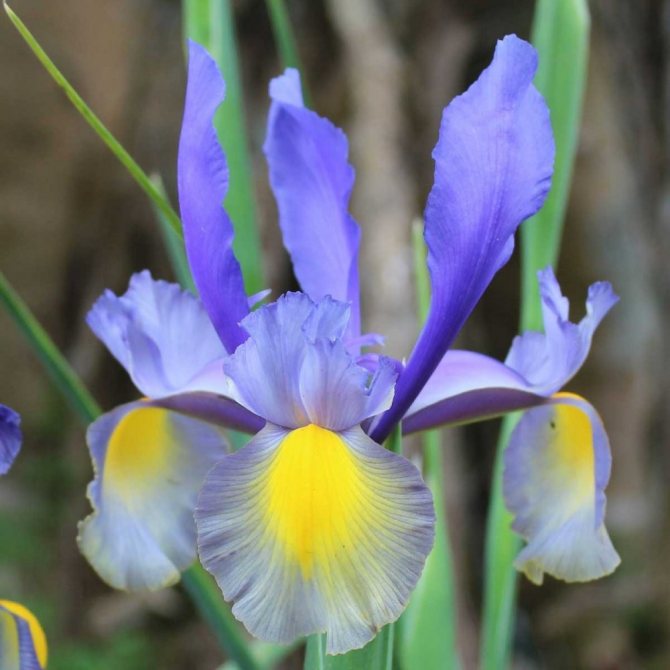

Dutch iris belongs to hybrids. Just by its appearance alone, it becomes clear that this is a noble flower. In today's flower shops, these irises are most often presented in the form of bulbs, up to seven centimeters long. Covered with scales in several layers. An adult plant can grow up to half a meter in height. And the flowers can be of very different colors - from orange and white to lilac and blue.
Such irises begin to bloom by the end of spring - closer to the beginning of summer. The leaves dry completely only towards the beginning of autumn. It is not difficult for them to survive the cold on their own, however, if the frosts are very strong, you should take care of shelter for them. These flowers adore the sun's rays, and the soil should be of medium humidity and acidity. Dutch iris is grown both for simple decoration of plots and for cutting for sale.
Pseudoair
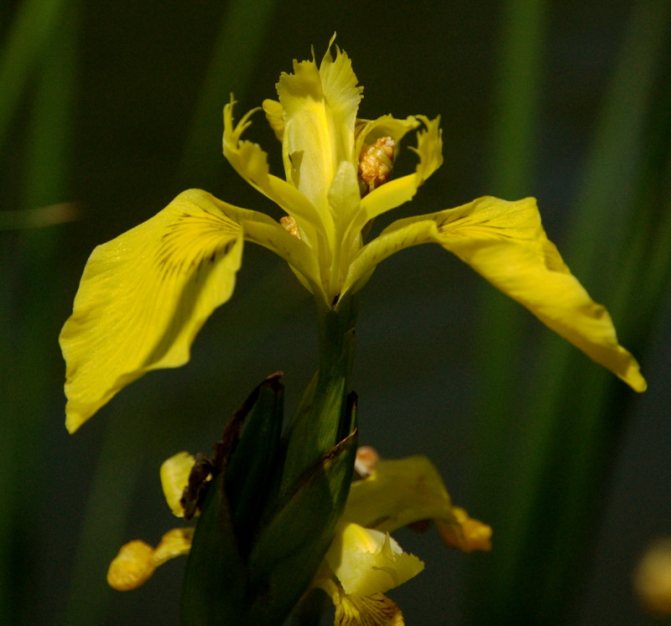

Swamp, as it is popularly called, iris is the most tenacious species. Scientifically false, he is. The plant can grow near any bodies of water, in the water itself and in swampy soil. But this does not mean that planting irises in open ground is impossible. No - everything is very possible. This type of iris is capable of growing for several years and practically does not ask for any special attention.
Xiphoid
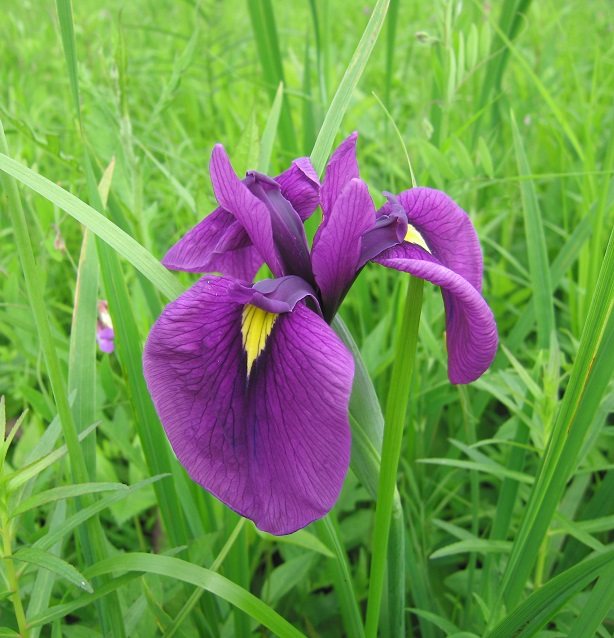

The xiphoid iris is endowed with a truly non-standard bud shape. But these plants are suitable only for experienced gardeners, since they are very capricious and require special attention to themselves. For example, during flowering, it requires a soil of weak acid and medium moisture. That there was no lime.
The main problem that appears in the growing process is dry wintering. Due to this, for the winter period, xiphoid irises are covered with dried oak foliage, and they are covered with polyethylene on top. Flower roots must not be overdried. Growing in special pots or boxes helps to solve most of the problems of these flowers. With the onset of winter, they are simply taken to a room that does not freeze through.
Siberian
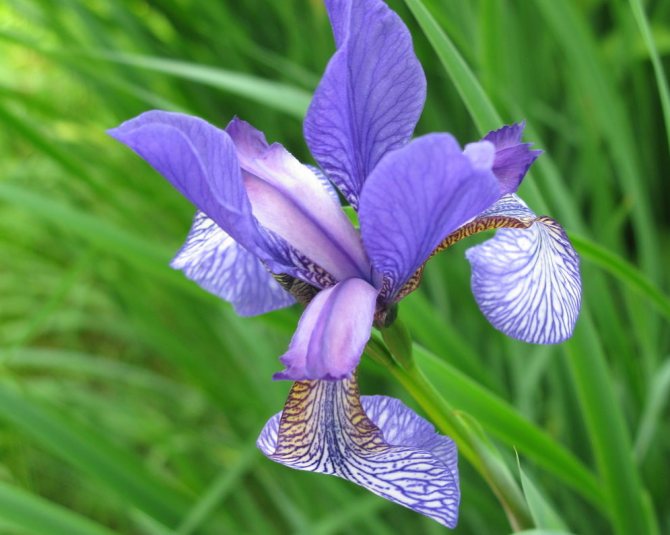

There are not so many flowers that can be compared with the relatively unpretentious Siberian iris in their luxury. Its flowers are collected at the very top of the peduncle. It is this species that is always the most striking decoration of the entire garden. Siberian iris blooms profusely throughout each year.This flower has many advantages - it has excellent resistance to disease, wind and cold. And in the palette of their color, it seems that all the colors of the rainbow are really collected. This amazing flower has one more interesting quality - it not only has its own immunity to bacteriosis, but also heals the soil from this disease. It will take about three years for Siberian iris to completely heal a plot of land.
Iris care
How to care for irises in the garden
Love for warmth and light is the main feature of irises. As for watering, it is important to strictly monitor the amount of moisture received by plants in the budding phase. During this time, watering should be regular and sufficient. In general, irises should be watered only when the soil near the roots becomes very dry.
Karbofos - from planting to digging
As for feeding, in most cases, fertilization of the soil will be sufficient during the spring preparation of the site. But if you think that plants need nutrition, then it is appropriate in the form of a solution of phosphorus-potassium fertilizers applied under the root during growth, but it is categorically impossible to fertilize irises during flowering.
- Physalis: planting and care in the open field
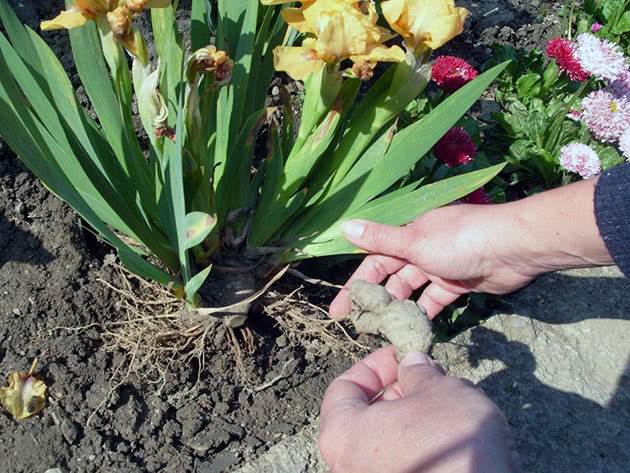

In the photo: Iris rhizome
You will have to fight weeds throughout the growing season. Weeding is done by hand because the horizontally developing root system of the irises is very close to the surface and you can accidentally disturb it with a hoe. Occasionally, you still need to loosen the soil, only this must be done very carefully, trying not to damage the roots. And one more thing: do not be lazy to remove wilted flowers, otherwise they can become a breeding ground for pests.
Karbofosa for lush bloom
Diseases and pests of irises
The more graceful and variegated the iris variety in the flower bed, the higher the likelihood of it being affected by diseases and pests. The main condition for the health of your plants is compliance with all the rules of agricultural technology of the species. In addition, it is necessary to monitor the "well-being" of irises throughout the growing season in order to see the problem in time and be able to eliminate it.
If the plant is affected by fusarium or another type of rot, the delay of death is similar: you need to immediately remove and destroy the diseased specimen and be sure to shed the remaining irises along the roots and under the root with a two percent solution of Fundazol. Use this drug as a preventive treatment of rhizomes before planting, then the risk of the likelihood of the disease will be reduced.
As a preventive measure against spotting of all types, irises are sprayed with a 1% solution of Bordeaux mixture.
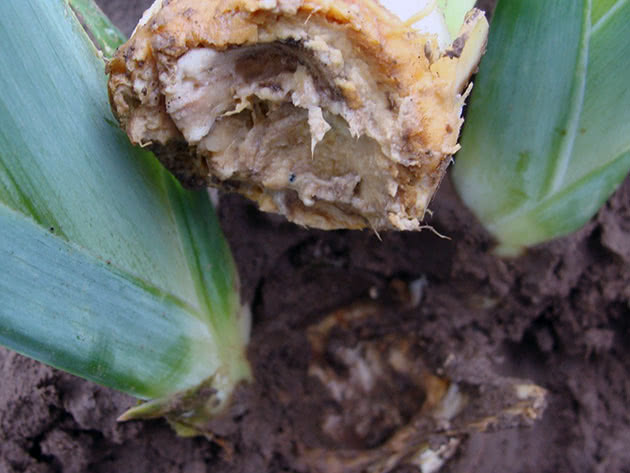

In the photo: Iris rots
Of the pests, the irises are most often affected by scoops, eating away the bases of the peduncles, as a result of which they turn yellow and die. To avoid this problem, at the beginning of the growing season, irises should be sprayed twice with a weekly interval with a ten percent solution of karbofos.
They attack irises and gladiolus thrips, from which photosynthesis is disturbed in the leaves of plants, they become brown and dry out. Iris buds affected by thrips become ugly and discolored. The risk of infection by thrips is especially high during dry summers. The problem can be eliminated with the help of Karbofos, as in the case of the scoop, or by spraying the plants with a strained ten-day infusion of 400 g of shag with the addition of 40 g of grated laundry soap.
Slugs can become pests of irises. To get rid of them, spread wet rags or burdock leaves, which the slugs use as shelter, between the iris bushes, then collect them together with the slugs and destroy. There is another way to deal with slugs: in dry weather, early in the morning or in the evening, scatter granular metaldehyde over the area at the rate of 30-40 g per 10 m2.


Diseases and pests of irises


The more graceful and variegated the iris variety in the flowerbed, the higher the likelihood of it being affected by diseases and pests.The main condition for the health of your plants is compliance with all the rules of agricultural technology of the species. In addition, it is necessary to monitor the "well-being" of irises throughout the growing season in order to see the problem in time and be able to eliminate it.
If the plant is affected by fusarium or another type of rot, the delay for the plant is like death: it is necessary to immediately remove and destroy the diseased specimen and be sure to shed the remaining irises along the roots and under the root with a two percent solution of Fundazole. Use this drug as a preventive treatment of rhizomes before planting, then the risk of the likelihood of the disease will be significantly reduced.
As a preventive measure against spotting of all types, spraying of irises with a 1% solution of Bordeaux mixture is used.
Of the pests, the irises are most often affected by scoops, eating away the bases of the peduncles, as a result of which they turn yellow and die. In order to avoid this problem, it is necessary at the beginning of the growing season to spray irises twice with a weekly interval with a ten percent solution of karbofos.
They attack irises and gladiolus thrips, from which photosynthesis is disturbed in the leaves of plants, they become brown and dry out. Iris buds affected by thrips become ugly and discolored. The risk of infection by thrips is especially high during dry summers. The problem can be eliminated with the help of Karbofos, as in the case of the scoop, or by spraying the plants with a strained ten-day infusion of 400 g of shag with the addition of 40 g of grated laundry soap.
Slugs can become pests of irises. In order to get rid of them, spread wet rags or burdock leaves between the bushes of irises, which the slugs will use as shelter, then collect them together with the slugs and destroy. There is another way to deal with slugs: in dry weather, early in the morning or in the evening, scatter granular metaldehyde over the area at the rate of 30 to 40 grams per 10 m2.
Irises after flowering
If you are not going to plant your irises this year, then it is best to cut the flower stalks after flowering is complete. If the leaves begin to turn yellow, you can cut off the yellowness by making the tip of the leaf semicircular - it looks very cute, and your iris will still decorate the flower bed, and its rhizome will gain nutrients for growth and flowering next year.
If the autumn is warm, then the irises can bloom again.
When the leaves finally dry out, cut them off at a height of 10-15 cm and burn them in order to destroy possible pest eggs or pathogens.
Before the onset of cold weather, sprinkle the bare roots of irises with earth, cover the area with a layer of sand or peat 8 to 10 cm thick.If there is a possibility of a strong or prolonged winter, cover the area with dry foliage or spruce branches. If the winter is snowy, the irises will not need shelter.
Irises after flowering
If you are not going to plant your irises this year, then it is best to cut the flower stalks after flowering. If the leaves begin to turn yellow, you can cut off the yellowness by making the tip of the leaf semicircular - it looks very cute, and your iris will still decorate the flower bed, and its rhizome will gain nutrients for growth and flowering next year.
If the autumn is warm, the irises can bloom again.
When the leaves finally dry out, cut them at a height of 10-15 cm and burn them to destroy possible pest eggs or pathogens.


In the photo: Reproduction of irises by division
Before the onset of cold weather, sprinkle the bare roots of irises with earth, cover the area with a layer of sand or peat 8-10 cm thick.If there is a possibility of severe or prolonged frosts, cover the area with dry foliage or spruce branches. If the winter is snowy, the irises will not need shelter.
Reproduction of irises
You can increase the plant population using two options: by dividing the rhizomes or by buds.
Every 3 years, we pay attention to the division of the culture by the rhizome, which can be organized both after flowering and in early spring.


We divide a strong, well-formed bush with a well-sharpened knife into several parts. For each separate part, which has a strong rosette of leaves, we halve the length of the leaves, leaving 7-10 cm and the roots - the remainder of 5-7 cm.
If you do not divide, then after 5-6 years without a transplant, they bloom poorly or stop flowering altogether. This happens as a result of depletion of the soil and its compaction, where actively expanded rhizomes oppress each other, intertwining with each other, which makes it very difficult for the fruitful growth of neighboring rhizomes.
Next, the iris cut must be disinfected for half an hour in a prepared composition of 80 g of the preparation "Hom" - 10 liters. This solution helps to destroy all disease-causing organisms.
After processing, we leave the cut in a sunny place for 2-3 days. The sections remaining after the knife must be covered with crushed coal.
Next, we land on a permanent place, but shallow, almost at the surface with a slight slope. That is, the bud should be at ground level, and part (upper) of the rhizome should not be covered with earth. We will organize a good strait.
Abundant flowering usually occurs in the third year.
As a rule, especially valuable specimens are propagated by buds if there is very little planting material. When the buds are clearly visible, usually in August, they, together with pieces of rhizome, must be planted in a greenhouse or garden bed (preferably in partial shade), which has a temporary cover. We plant it along the grooves, embedding it in the ground by 2.5-3 cm, we spill well. Be sure to monitor the moisture content of the soil.
After the plants take root, they are ready to be planted in flower beds. Usually this can already be done next spring, but it is best to wait until August, before doing weeding, watering, loosening, and feeding them.
Iris storage
If you bought or dug up rhizomes of bearded irises in the fall and want to keep them until spring, the best place to store them is in a cold, dry room. Fold the well-dried roots in a box and take them out onto a balcony or loggia. You just need to first wrap each root in paper, cloth or sprinkle them in a box with dry sawdust or dry peat.
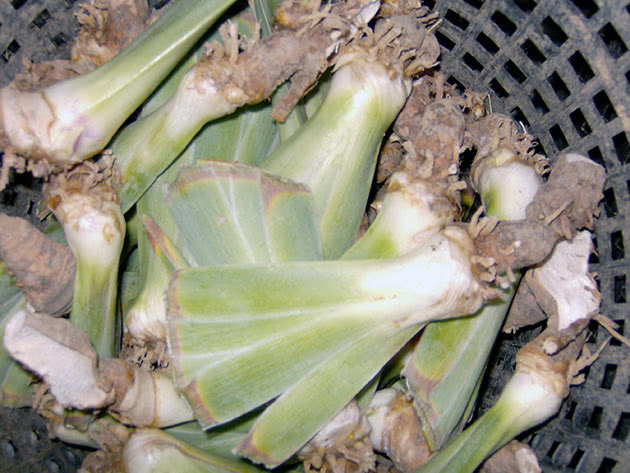

Photo: Preparing irises for storage
All other types of irises are moisture-loving, so the best way to keep the root of the iris until spring is to plant it in a flowerpot, after cutting off the long roots, disinfecting it in a weak solution of potassium permanganate and drying it after that. The root is not immersed deeply in the ground, lightly sprinkled with earth on top. In the spring, the sprouted root, together with an earthen clod, is planted in the ground.
The benefits of irises
In modern medicine, the benefits of the iris plant are known. True, it is allowed to use only a few varieties, which include the Germanic and Florentine varieties. The raw material for the production of medicines is the rhizome of the plant, from which the essential oil is extracted.


Rhizomes are harvested three years after planting. In order to use the rhizome, it must be thoroughly rinsed with water and removed from the roots. After drying, they are stored in a closed jar.


Types and varieties of irises
Bearded irises
According to the flower shape, root irises are divided by botany into bearded and non-bearded ones. Bearded irises, so called because of the shaggy hairs on the petals, have their own classification (tall, medium-sized, curb, standard medium-sized, small-flowered medium-sized, medium-sized binder, standard dwarf, miniature dwarf, table, arylbreds, aryls and aryllopredbreds, arylbreds, arylbreds, arylbreds, arylbreds and aryl-like arylbreds). But this classification is for scientists, for amateur flower growers they are all just bearded irises of different sizes.
- Physalis: planting and care in the open field
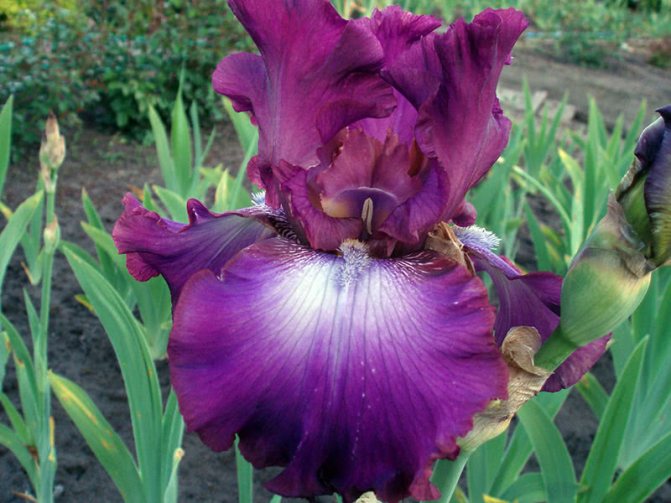

In the photo: Bearded irises
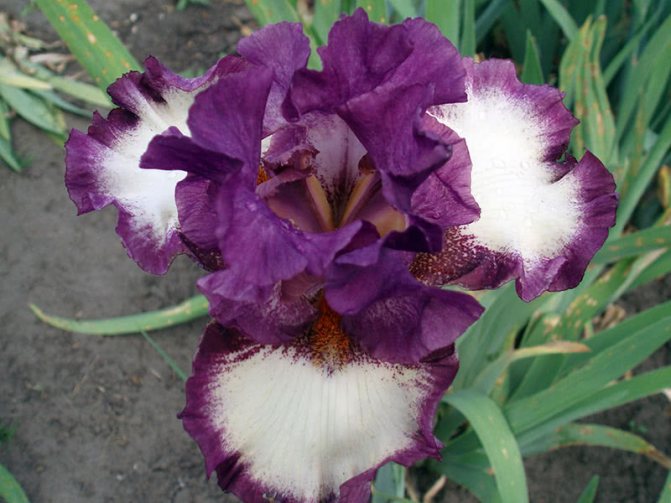

In the photo: Bearded irises
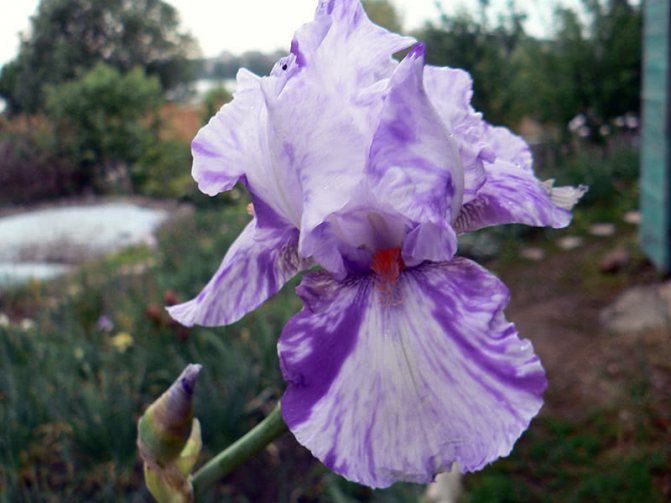

In the photo: Bearded irises
German Iris (Iris germanica)
In culture, there are hundreds of varieties of tall bearded iris, which also exists under the name German iris. Iris Germanic - the most common type of bearded iris. Here are some popular varieties that will brighten up any garden:
- Baltic Sea - strongly corrugated irises of deep blue color with blue beards;
- Bewilderbest - corrugated creamy burgundy red with stripes and strokes of yellow and white;
- Acoma - sky blue-ivory with lavender border, very popular with Americans.
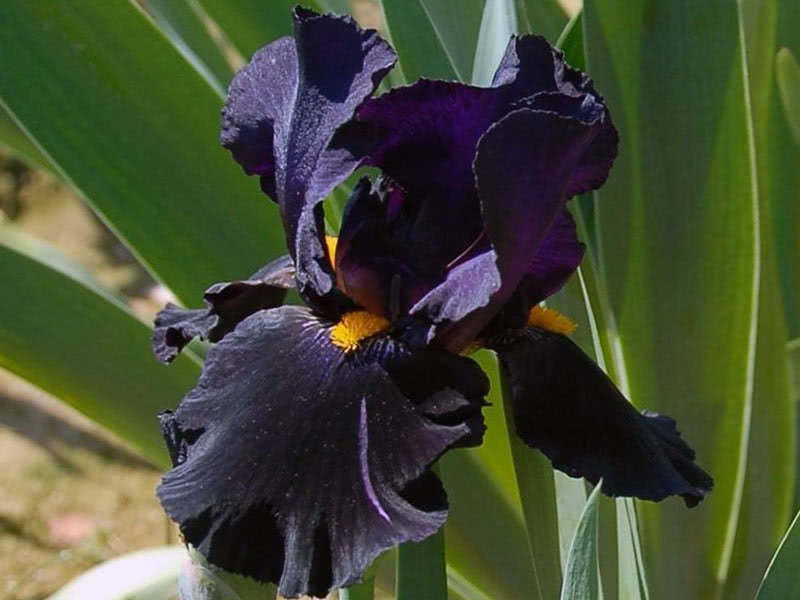

German Iris (Iris germanica)
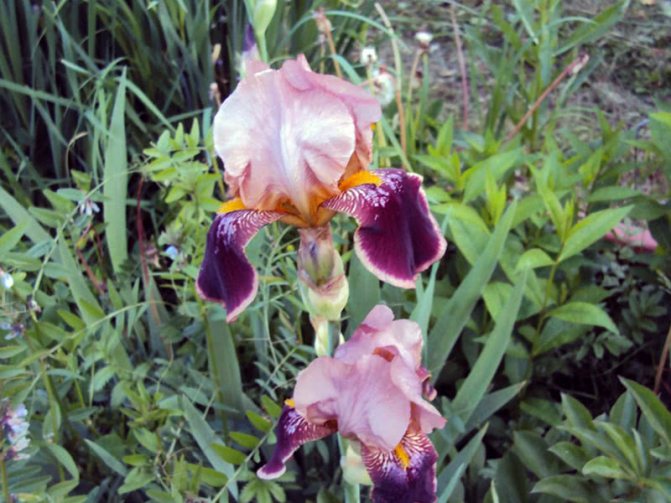

German Iris (Iris germanica)
Non-bearded irises
The generalized name is conditional, includes the following species: Siberian iris, Japanese iris, spuria iris, Louisiana iris, Californian iris, marsh iris and other irises (specific and interspecific). We will tell you about the most popular species in our latitudes:
Siberian Iris (Iris sibirica)
Whose natural color varies from blue to dark purple, although today about 1000 varieties with different colors have already been bred, for example:
- irises white Snow Queen;
- Imperial opal 80 cm high, pink lavender color, flowers up to 10 cm in diameter;
- iris yellow with white border Batts & Suga.
There is only one drawback - Siberian iris is devoid of aroma.
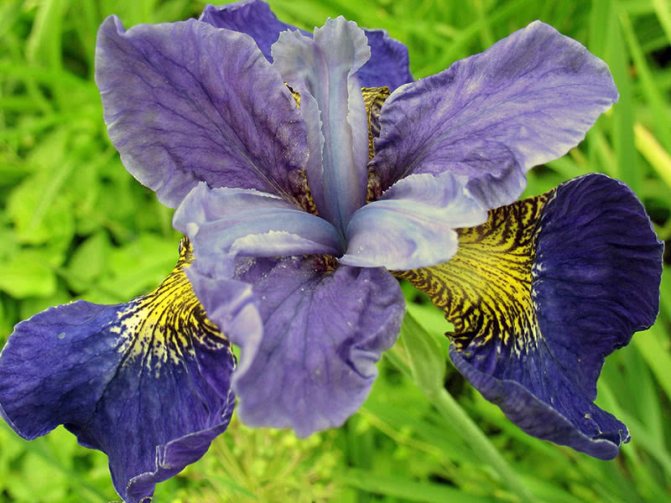

In the photo: Siberian Iris (Iris sibirica)
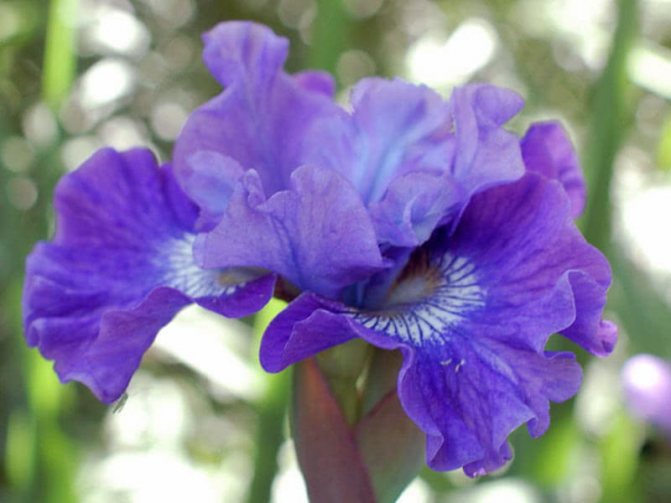

In the photo: Siberian Iris (Iris sibirica)


In the photo: Siberian Iris (Iris sibirica)
Japanese Iris (Iris japonica)
He is the xiphoid iris, he is the Kempfler iris with large orchid flowers up to 25 cm in diameter, odorless. Japanese breeders have developed a multi-petal and terry garden form of Japanese iris, which is called hana-shobu. Unfortunately, this species is not frost-resistant, therefore, varieties bred specifically for our latitudes are recommended for flower growers:
- Nessa-No-Mai - purple with white, flowers - up to 23 cm in diameter;
- Solveig - delicate light lilac iris;
- Vasily Alferov ink-colored non-double iris;
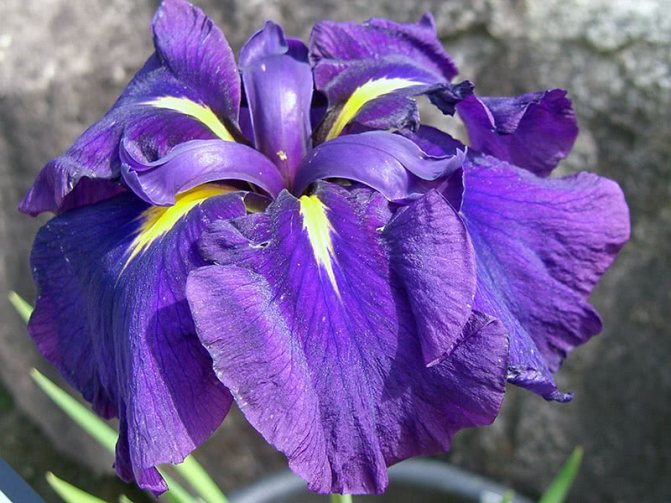

In the photo: Japanese Iris (Iris japonica)
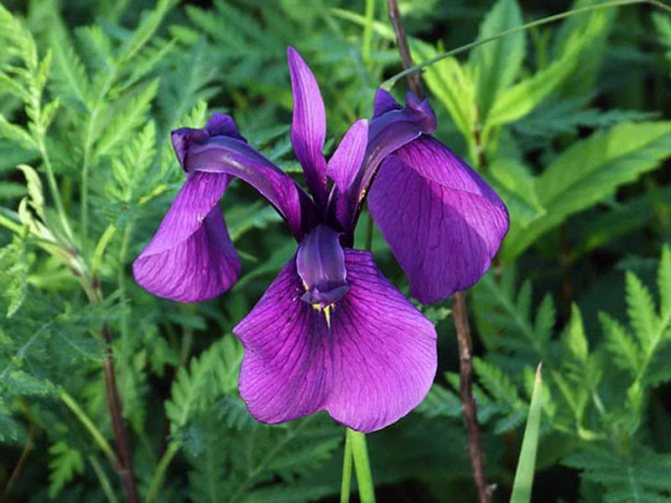

In the photo: Japanese Iris (Iris japonica)
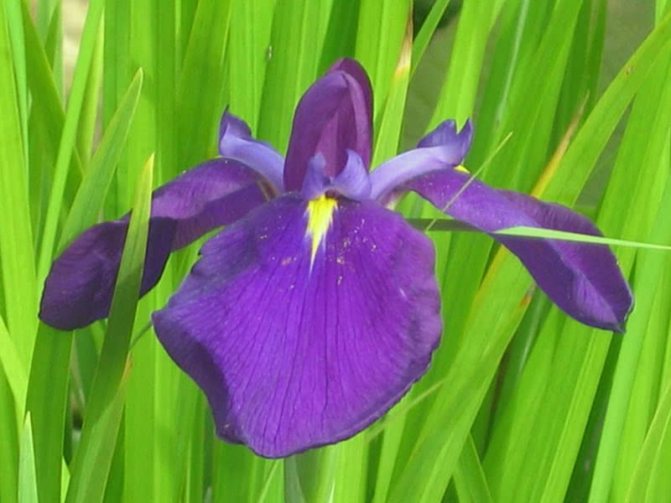

In the photo: Japanese Iris (Iris japonica)
Iris spuria
Very elegant, similar to the bulbous iris xyphyum, but much larger. In addition, spuria iris is frost-hardy and drought-resistant. Of the most beautiful:
- Lemon touch - lace yellow-lemon with a darker gold signal, high - 1 m;
- Transfiguration - the same tall iris from dark purple to blue-purple in color with a bronze signal;
- Stella Irene - purple-black with a small gold signal, height 90 cm.
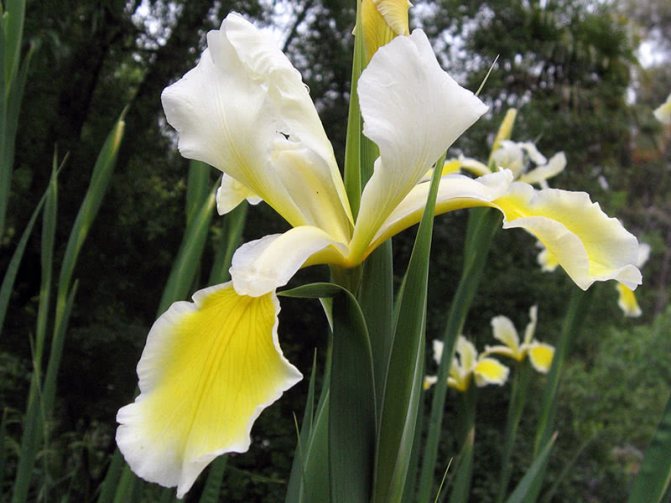

In the photo: Iris spuria


In the photo: Iris spuria
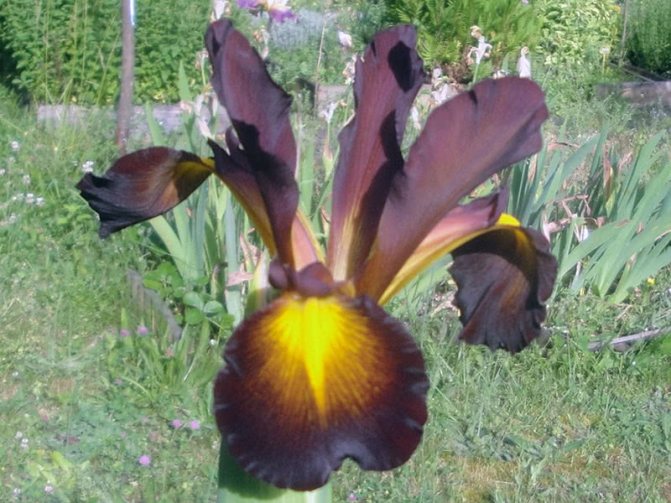

In the photo: Iris spuria
Bulbous irises
In Russia, botanical scientists exclude bulbous plants from the genus Iris, however, in the Western tradition there are bulbous irises, and with this name they come to us for sale from nurseries and farms in Holland. Dutch irises are widely represented on our shelves.
Bulbous irises include three types: iridodictium (netted iris), juno (Bukhara iris), xyphyum. Net iris is the most winter-hardy and stable in the conditions of central Russia. It blooms in early spring, does not require annual digging of bulbs, and has a large number of varieties of various colors.
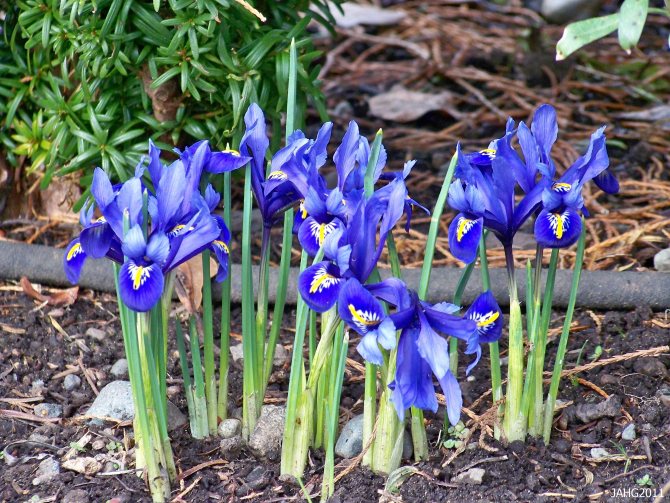

Bouquets of irises
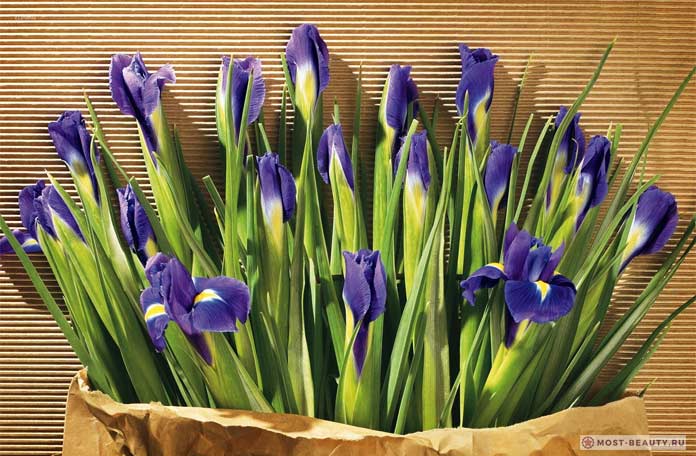

Iris are considered a symbol of friendship, so a bouquet of them is a great opportunity to express your gratitude to a close friend. Floral arrangements of these flowers will be appropriate only as a gift for romantic girls. Also, as a symbol of good news, it is appropriate to give a bouquet of irises when you leave the hospital. But don't give these flowers to business partners.
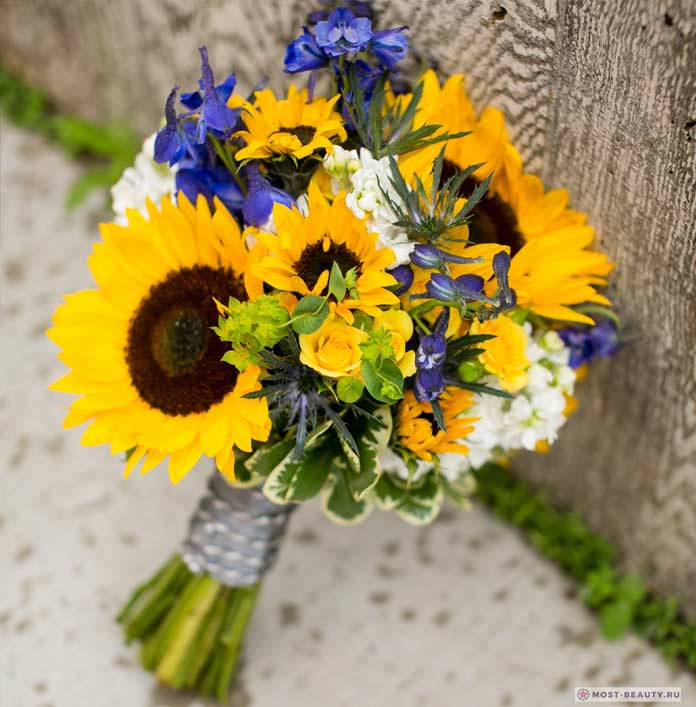

Beautiful bouquets of irises are obtained in combination with tea and any yellow roses, pink and snow-white carnations, lilies and daisies. Colorful spring compositions are obtained with yellow tulips and crocuses, and autumn ones - with sprigs of white chrysanthemums. It is not customary to combine them with gladioli.
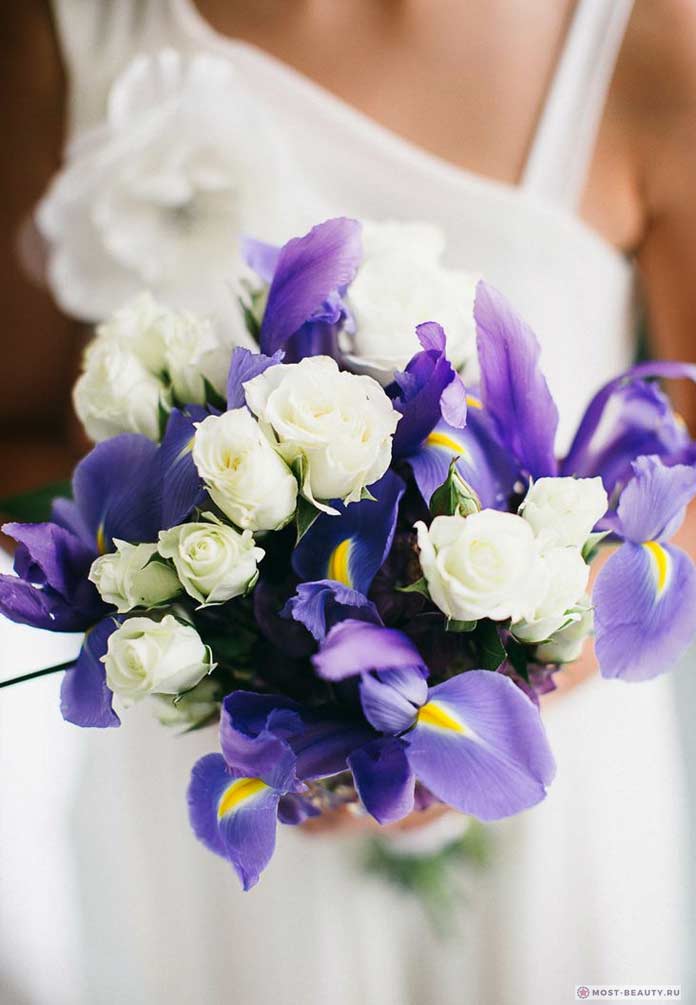

Irises in a wedding bouquet are a vivid evidence that the bride is ready to throw a daring challenge to all established stereotypes. Flowers of the traditional violet-lilac scale will look most advantageous against the background of a white dress.For such a solemn occasion, compositions of irises with tulips, white roses and bells, which will emphasize the delicate image of the bride, are also perfect. Bouquets of lilac and yellow flowers will be appropriate for a wedding where boho style reigns.
And you can read about other equally beautiful bouquets in an interesting article on our website.
Main types, varieties with photos
The classification of these colors still raises many questions. For example, there is a variety of iris that comes from interspecies crossing. There are varieties obtained by crossing several varieties. In this regard, amateur gardeners have created their own classification by external signs. The most common group is the bearded iris (Blaches, Babeling Brook, hybrids of variegated and pale, German iris). Due to the huge variety of colors (pale cream, white, blue), you can choose a variety for any landscape composition. The height of the plants is also different:
- Tall - grow up to 70 centimeters and above.
- Medium height - 40-70 cm.
- Dwarf - no higher than 40 cm.
Miniature plants growing up to 20 centimeters bloom very early. The rest of the varieties have different flowering periods. Having planted several varieties in a flower bed, you can enjoy beautiful flowers for several months in a row.
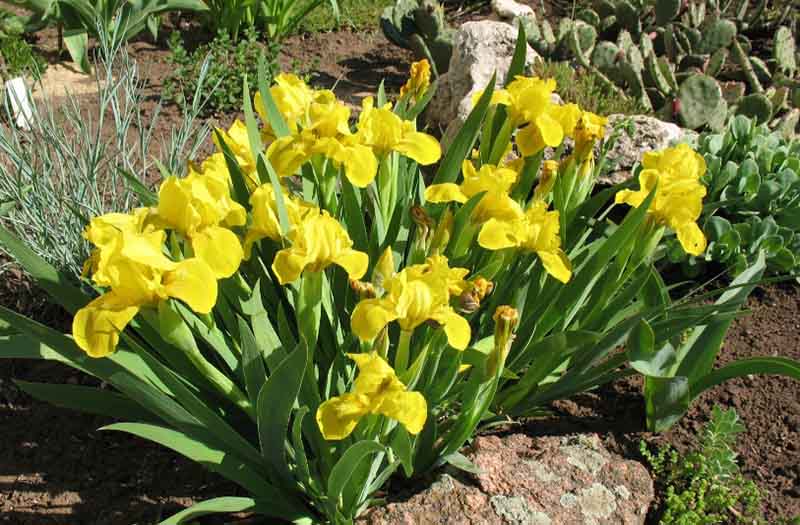

Dwarf irises
Light-bearded or water-loving plants are the next category of flowers, which includes hybrids of marsh, smooth and colorful iris. One of the main advantages is moisture-loving. If you need to plant near a lake or in shallow water, there is no better option. What does the water-loving iris flower look like? As a rule, its color is very modest, with yellow and blue shades prevailing. The leaves are xiphoid, narrow and long. It grows well on acidic soils, propagates vegetatively and by seeds. The most common in our country: Berlin Tiger, Variegata, Flore Plena, Golden Queen.


Iris marsh
We have described bearded and non-bearded iris, listed their varieties. Now let's look at another category of flowers that are popular in our country. We are talking about Siberian iris. This group includes many hybrids of the horned, blood-red and Siberian species. They are distinguished by beautiful and lush flowers, frost resistance, juicy leaves that do not turn yellow all summer. Modern varieties include the Book of Secrets, Bundle of Joy, Dance and Sing.
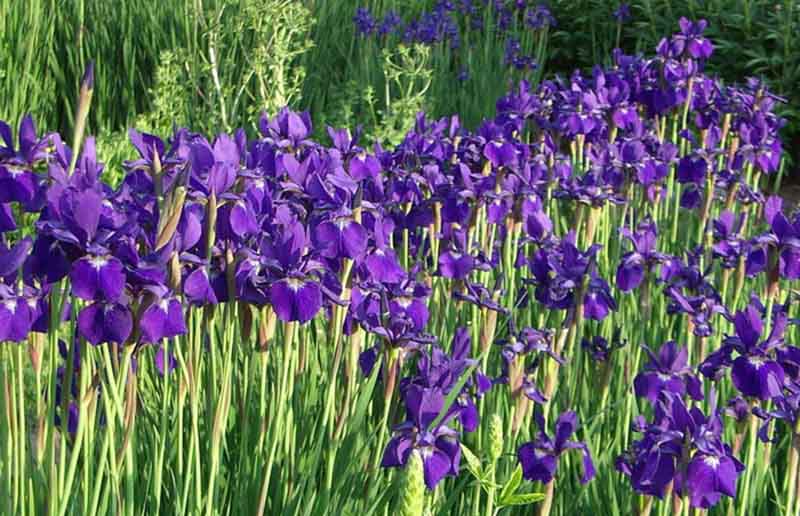

Siberian iris
Siberian irises that came to us from China are called chrysographs. The leaves are light green, the bush is looser. You can recognize a chrysograph by the specks and leaves that cover the petals. The category of Japanese irises combines several varieties of the xiphoid type. Breeding work is mainly carried out in Japan - hence the name. In our country, Japanese irises can survive the winter without additional shelter only in the south of Russia. They love weakly acidic soil, in places of stagnant water and with strong waterlogging they grow poorly. In nature, bearded Japanese are also found, combining the best characteristics of the two groups of plants.
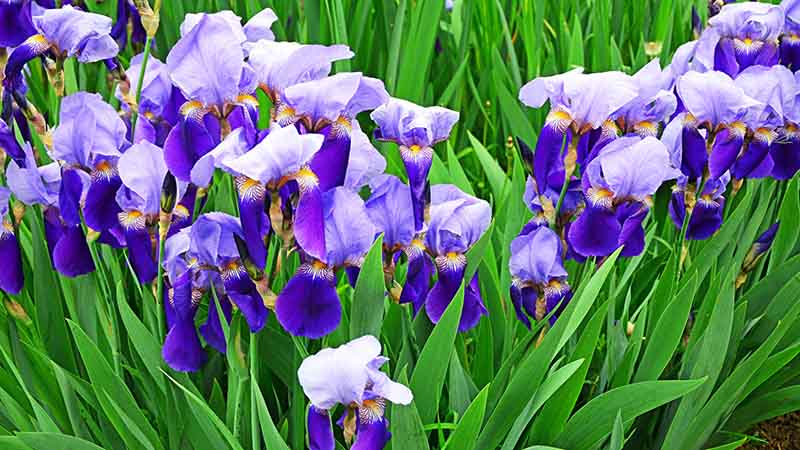

Iris chrysographis
Russian botanists generally exclude the so-called bulbous irises from the genus Iris. Whereas Western scientists distinguish them as a separate class of irises. They bloom in early spring, do not need annual bulbs digging from the ground.
Basic rules of care
Weeds are removed throughout the season. It is best to do this by hand to avoid damaging the roots that are too close to the surface. Occasionally, loosening is carried out, the wilted flowers are removed.
Any type of plant, including purple iris, is warm and light-loving. Needs regular watering - especially during bud formation. Fertilizers are applied in the spring. As a rule, if you did this in April-May, you can skip top dressing until the end of autumn. By the way, during the flowering period it is even prohibited.


Irises in art


In the photo: Mikhail Prishvin
The writer Mikhail Prishvin argued that the elegance of these flowers surpasses even roses. Since ancient times, they have inspired creators to create bright floral masterpieces. The oldest image is found on the temple of the Knossos Palace. Pictures of irises can also be seen in old Japanese prints.
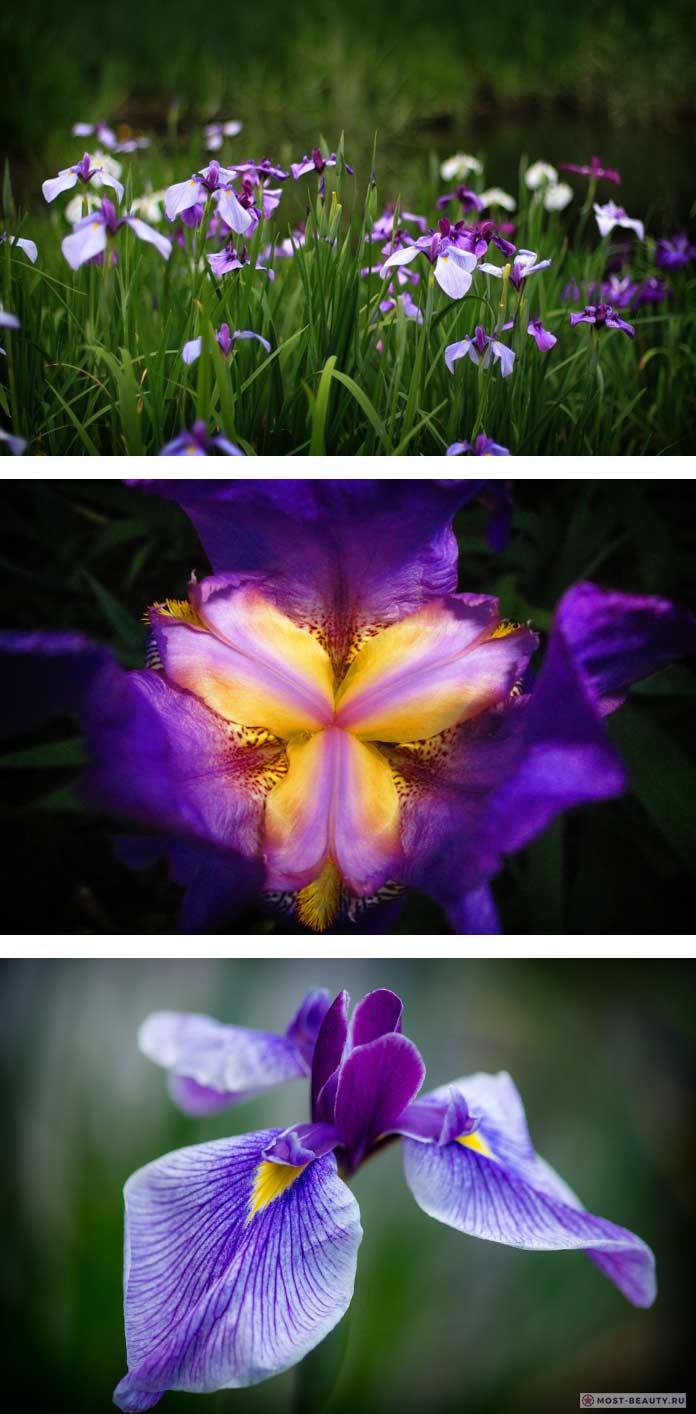

The diversity of colorful petals inspired many Renaissance painters. Daniel Wolf dedicated a romance to these flowers, and Bella Akhmadulina wrote in one of her poems that they are loved more than others, and they have no equal.


Photo: "Irises in Monet's Garden", Claude Monet, 1900
Rainbow irises have repeatedly served as a source of inspiration for the main flower painter - Claude Monet. Admiring their variegated colors in his garden, he wrote several works on this topic.
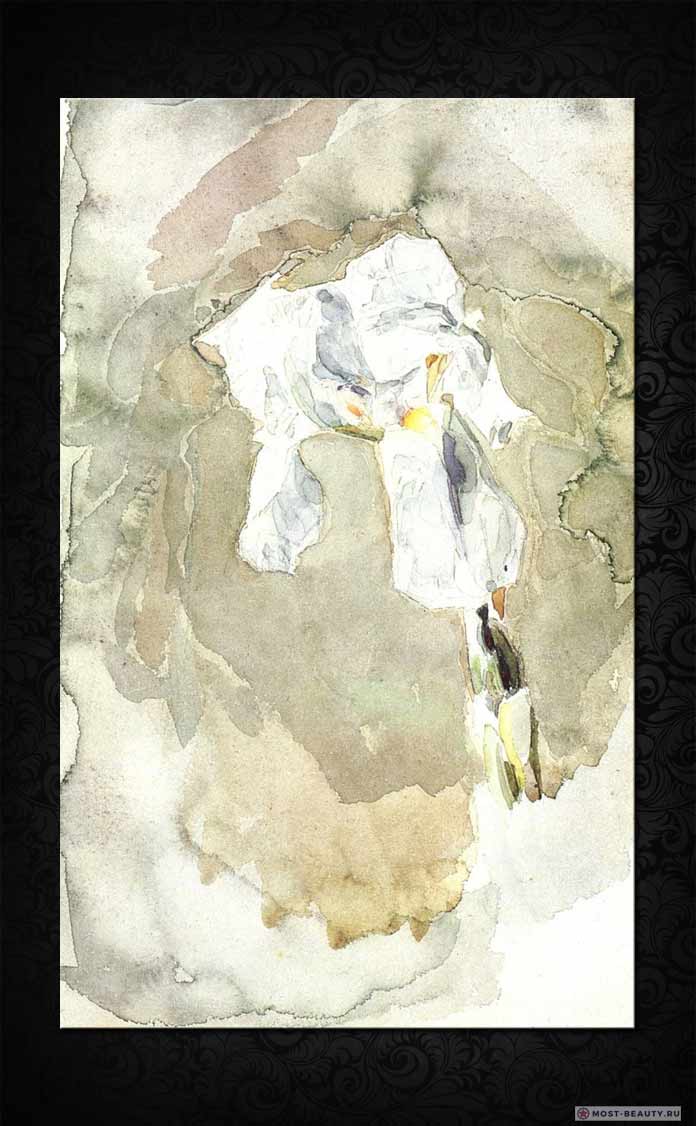

In the photo: "White Iris", M.A. Vrubel, 1887
White iris can be seen in Vrubel's painting, and the most naturalistic depiction of this flower is reflected in the work of Dürer.
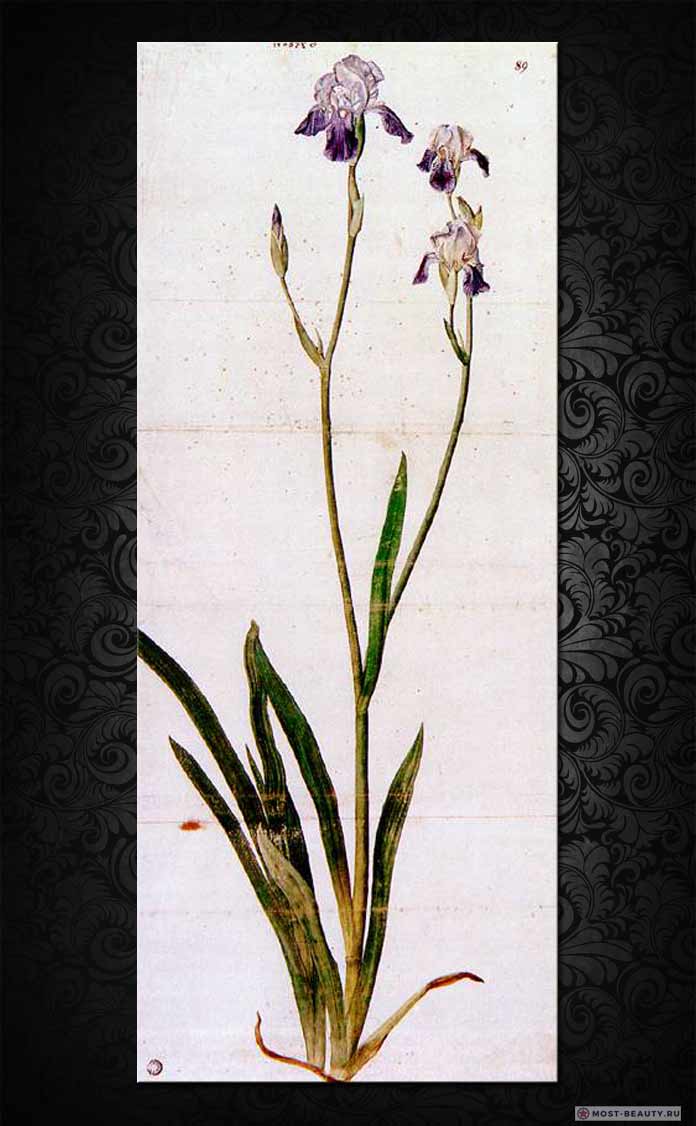

In the photo: "Iris", Albrecht Durer
Irises also played a special role in the work of Van Gogh. It was them that he depicted in the first picture, painted in a home for the mentally ill, where he found himself after an incident with a cut off ear. Creating his "Irises", the artist hoped to overcome mental suffering and find the strength to create further. The painting attracts with the most realistic beauty of flowers compared to Monet's impressionist works.
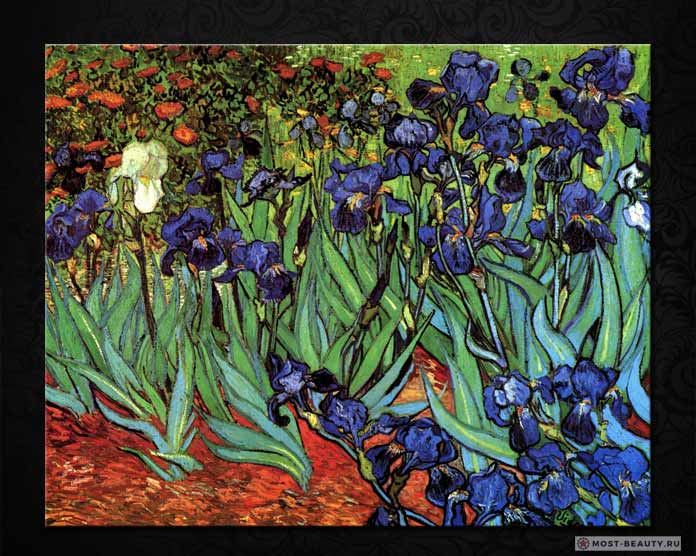

Irises, Van Gogh, 1889
Among oriental creators of particular interest are the works of Utagawa Hiroshige - a Japanese artist of the 19th century, author of more than 5,000 prints, among which there is a whole series dedicated to irises.
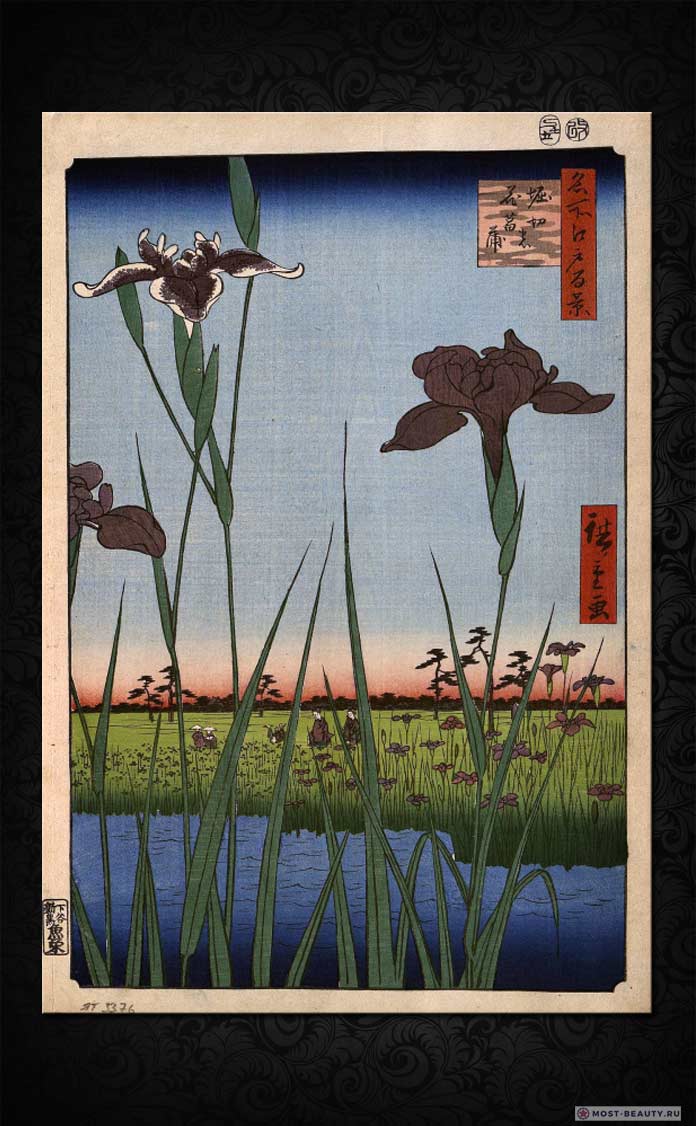

Irises in Horikiri, Utagawa Hiroshige
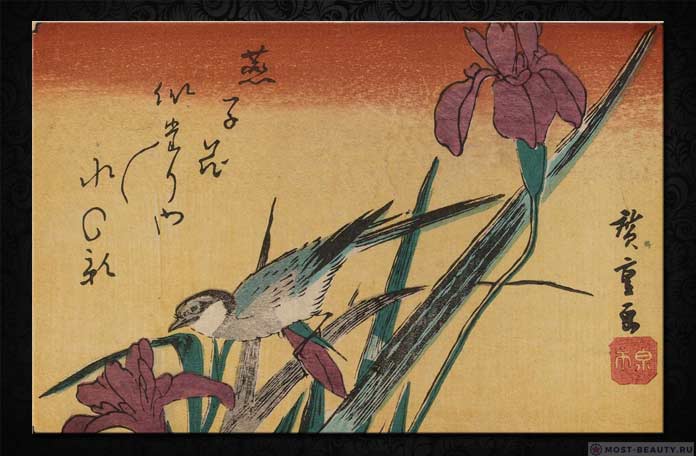

"Wagtail and Irises", Utagawa Hiroshige

